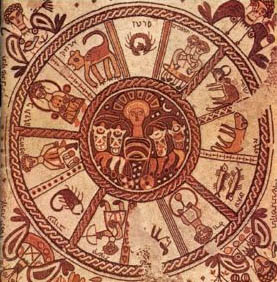

The most elaborate description of the need for following the seasons, without an official calendar, is the text appearing in a series of poems by the ancient Greek writer Hesiod, Works. But this ancient writer refers not only to the seasons as determined by the relationship between the earth and the sun, but also to the observation of other heavenly bodies as stars and constellations, as well as natural phenomena like the seasonal appearance of various creatures and plants. Here is a very concise extract from the book of Works, taken from The Online Medieval and Classical Library:
"(ll. 383-404) When the Pleiades are rising, begin your harvest, and your plowing when they are going to set. Forty nights and days they are hidden and appear again as the year moves round, when first you sharpen your sickle.
(ll. 414-447) When the piercing power and sultry heat of the sun abate, and almighty Zeus sends the autumn rains, the star Sirius passes over the heads of men only a little while by day and takes greater share of night, then, when it showers its leaves to the ground and stops sprouting, the wood you cut with your axe is least liable to worm. Then remember to hew your timber: it is the season for that work.
(ll. 448-457) Mark, when you hear the voice of the crane who cries year by year from the clouds above, for she gives the signal for plowing and shows the season of rainy winter, then is the time to feed up your horned oxen in the byre.
(ll. 479-492) But if you plow the good ground at the solstice, you will reap sitting, grasping a thin crop in your hand, binding the sheaves awry, dust-covered, not glad at all.
(ll. 504-535) The frosts are cruel when Boreas (the north wind — T.B.) blows over the earth. When the season of frost comes on, stitch together skins of firstling kids with ox-sinew, to put over your back and to keep off the rain.
And to conclude:
(ll. 582-596) But when the artichoke flowers, and the chirping grass-hopper sits in a tree and pours down his shrill song continually from under his wings in the season of wearisome heat, then goats are plumpest and wine sweetest; women are most wanton, but men are feeblest, because Sirius parches head and knees and the skin is dry through heat. But at that time... let me drink bright wine, sitting in the shade, when my heart is satisfied with food, and so, turning my head to face the fresh Zephyr (westerly wind — T.B.), from the overflowing spring, which pours down, unfouled.
There is no evidence of any official calendar existing in Greece in the days of Hesiod (whose estimated date of writing is around the 8th Century B.C.); but his knowledge of the seasons and the work and leisure connected with them is wide and full.
***
One of the natural seasonal markings made by Hesiod is that of the "Dog Star" Sirius; this is the very bright star that accompanies the constellation Orion, "The Hunter," as a dog follows his master on the hunt. This star was significant for the ancient Egyptians, marking the time of its first appearance above the horizon as hailing the overflow of the river Nile.
Egypt has no rainfall, either to wet the land for farming or to divide the year into wet and dry seasons. It's farming, which is one of the oldest in the world, entirely depends on the overflow of the river to wet the land and prepare it for planting. In consequence, the ancient Egyptian year was divided into three seasons: Inundation; Growth = Winter; Harvest = Summer.1
The best known reliance on heavenly bodies is the Babylonian zodiac, which is connected with the Babylonian calendar, beginning around the Spring equinox (as mentioned previously). The zodiac stems from the solar calendar, expressing an astronomical observation of the position of certain constellations in relation to the sun in monthly periods around the year:
Nisanu (the first month) - March/April (Spring equinox) – Aries
Aiaru (Procession month) - April/May - Taurus
Simanu (Time of brick making) - May/June - Gemini
Duzu (Month of Tammuz) - June/July (Midsummer) - Cancer
Abu (Month of torches) - July/August - Leo
Ululu (Month of purification) - August/September - Virgo
Tashritu (Month of beginnings) - September/October (Autumn equinox) - Libra
Arahsamnu (Eighth month) — October/November - Scorpio
Kislimu - November/December - Sagittarius
Tebetu (Month of violent rains) - December/January (Midwinter) - Capricornus
Shabatu (Month of rain) - January/February - Aquarius
Addaru (Month of threshing) - February/March — Pisces
Below is the Wheel of Zodiac, as it was found in a Byzantine synagogue floor in the ancient site of Beth Alpha in Israel. The names of the signs are written in Hebrew.

Note:
1 http://en.wikipedia.org/wiki/Egyptian_calendar






















